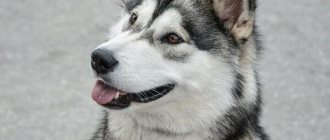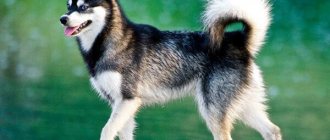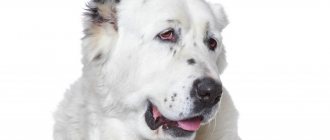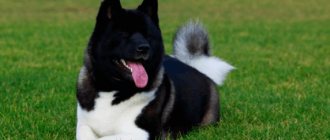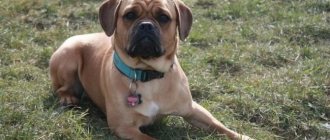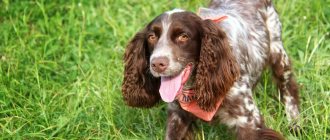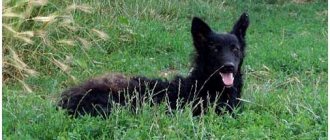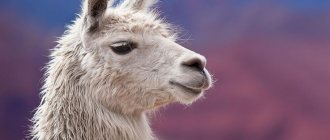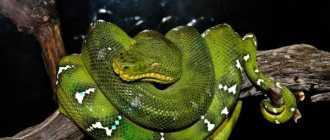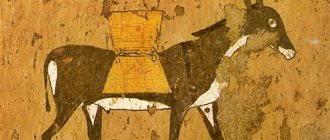More and more people are choosing small and medium-sized dog breeds for keeping them at home. They do not cause big problems in care and such a small pet can always be taken with you.
This type of breed also includes the Maltese (Maltese). Read more about this dog breed in our article.
History of the Maltese breed
Maltese
The history of the origin of the Maltese is full of hypotheses and assumptions and almost not a single reliable fact. According to experts, the glorious Maltese family is more than two thousand years old, and it’s not hard to believe, since the first images of big-eyed fluffies can be found in the drawings of the ancient Egyptians. As for the name of the breed, the lapdogs owe it to a geographical error.
At first, the animals were called Melites - in honor of the island of Meleda in the Adriatic Sea. However, this piece of land had a “twin brother” - today’s Malta, also called Meleda. At that time, there was simply no one to record the difference between these two islands, so they preferred to forget about it. Later, the Melite was renamed the Maltese, without paying attention to the fact that the real homeland of the animals was not Malta.
The breed's earlier history is no less controversial. In the debate about how the ancestors of the Melites reached the Adriatic coast, scientists reach the point of absurdity. Some experts attribute to lapdogs a relationship with the Tibetan terrier and a journey along the Silk Road from Asia to Europe. Scientists prefer not to mention that the above-mentioned route was not popular two thousand years ago. The version about the Swiss roots of the Maltese looks relatively plausible: in ancient times, the inhabitants of the Swiss Alps actually bred Spitz-shaped dogs that looked similar to today's lapdogs. Some researchers are trying to fit Melit poodles that lived on the islands of the Adriatic Sea into the pedigree, although these two breeds have nothing in common.
Maltese puppy
The popularity of Maltese dogs flourished during the Middle Ages. Most of all, France and Italy were in awe of glamorous pets. The Maltese fashion reached the shores of Foggy Albion only in the 16th century, and even later to America.
Famous owners of Maltese dogs:
- Susan Sarandon
- Patricia Kaas,
- Elvis Presley,
- Barack Obama,
- Elizabeth Taylor,
- Alla Pugacheva,
- Cindy Crawford.
Application
From the first day of its existence until today, Maltese dogs are exclusively companions. They were created to love and be loved.
At the same time, the Maltese breed demonstrates good watchdog and security qualities. Despite its tiny size, in case of danger the dog fiercely defends itself and its owner. True, not all pets have this trait.
It is worth considering that a small Maltese dog will not cope with protection. She can only bark or claw at an ill-wisher.
Moreover, pets sound the alarm for any reason. An unpleasant-smelling man passed nearby, the doorbell rang, they were shouting behind the wall, someone was climbing the stairs - and the Maltese immediately gave a voice. The dog should be weaned from excessive barking, otherwise complaints and complaints from neighbors will flow in a torrent.
A decorative dog is best suited for housewives, married couples, elderly people and all those who can and are willing to devote almost all their time to their pets.
Appearance of Maltese
Maltese dog after grooming
The breed characteristics of Maltese dogs are fixed by the standards of three cynological associations. For example, domestic breeders trust the standard of the International Canine Federation (FCI) more. In England, they prefer the set of characteristics approved by the UK Nursery (KC). The fluffies living on the other side of the Atlantic have their own standard, developed by the American Kennel Club (AKC).
For your information: American Maltese are very different from their European relatives. Transoceanic lapdogs weigh less (ideally up to 2.7 kg), their coat is much shorter, and their muzzle is slightly narrower than allowed by the FCI standard.
A separate caste consists of the so-called mini Maltese and baby-face Maltese. In the first case, these are miniature individuals weighing from 1.5 to 2.5 kg, which are more common among “Americans”. Babyface puppies are born to both American and European lapdogs. Their distinctive feature is a shortened muzzle, giving the dog a touching, deliberately childish appearance. Such animals are not allowed at exhibition events, but among Maltese lovers they are in high demand precisely because of their “photogenicity.”
Mini Maltese
American Maltese
Head
The Maltese skull is ovoid, of medium size (mesocephalic gradation), with well-developed brow ridges. The back of the head is flat, with a barely noticeable occipital protuberance. The parietal area is slightly convex, the line of the forehead is parallel to the line of the muzzle. The median groove is almost invisible.
The Maltese's muzzle accounts for ⅓ of the length of the entire head. As it moves away from the base, the muzzle gradually narrows and its tip becomes rounded. There is a pronounced stop between the forehead and nose (about 90°).
Nose
The face of a Maltese dog
The nose is straight, covered with long hair reaching the lower jaw. The lobe is large, moist, with well-opened nostrils. In individuals that meet the standard, the lobe is black, not slanted and does not protrude beyond the bridge of the nose.
Lips
The upper lip resembles a semicircle in outline and hangs slightly over the lower one. The Maltese's lips are black and covered with fur.
Teeth and jaws
The jaws are well developed, but not massive. The bite is complete, scissor-shaped, the teeth are strong and white.
Eyes
The purebred Maltese has large, round and slightly protruding eyes. The ideal iris shade is dark ocher. Eyelids with black edging, tightly fitting. The look is lively and open.
Ears
Maltese
Hanging type, close to the muzzle, in the shape of a triangle with a wide base. Standing tall. The fur on the outside of the ear is thick, reaching to the shoulders. When excited, the ears may rise slightly.
Neck
Hidden under abundant fur and held almost vertically. The length of the neck is approximately equal to the length of the head.
Frame
Deep chest with moderately curved ribs. The withers are not clearly expressed, the loin is smooth and strong. The groin areas are located quite low and slightly tucked up. The Maltese's croup is wide, even, with a slight slope in the tail area.
Limbs
The front legs of the Maltese are straight. The shoulder blades are movable, set at an angle of 60-65°. The shoulders are longer than the shoulder blades, inclined at an angle of 70°. Elbows pressed tightly to the body, looking straight. Turning the elbow outward or inward is considered unacceptable. There are rich featherings on the back of the forearms. The pasterns are almost vertical and strong. The paws are round, abundantly hairy, with black pads. Long hair grows between arched, balled toes.
The hind legs are straight. The hips are dense, prominent, slightly tilted forward. The legs are bony, the hock joints are normal with an angle of 140°. When viewed from behind, an imaginary line drawn from the hock to the floor should be vertical.
Tail
The Maltese's tail is a logical continuation of the dog's croup. In a calm state, it is gracefully curved and the tip touches the back (sometimes the standard allows for a slight deviation of the tail to the side). The tail is covered with soft hair that hangs over one side of the body. Ideally, the dewlap of the tail should reach the hock joints and, mixing with the hair on the body, form a lush cascade.
Satisfied Maltese
Wool
Maltese with long hair
Light, straight, flowing like a mantle. The undercoat is weakly expressed and almost invisible. In purebred lapdogs, the hair has a silky texture and is thick. The normal length of a Maltese coat is 20 cm or more. The coat should be smooth, outlining the contours of the body. The presence of protruding tufts of hair and so-called fringes is unacceptable. The exception is the back of the front and hind limbs. Here combs have a right to exist.
Color
The standard color of Maltese dogs is white. Not ideal, but an acceptable color option is ivory. Individuals whose coat has a pale orange tone are considered defective and are not included in exhibition events.
An interesting fact: until the beginning of the 20th century, most cynological associations allowed variability in Maltese colors. It was only by 1913 that a unified breed standard was approved, recognizing only individuals with white hair as purebreds.
Defects and vices of the breed
It is customary to classify as defects in appearance everything that does not fit into the framework of the breed standard. Deviations can be either mild, such as wrinkles on the head or a narrow croup, or serious, affecting the pet’s exhibition “career”. The main defects that threaten a Maltese dog with complete disqualification:
- disproportionate head;
- depigmented nose;
- bend of the back of the nose;
- severe undershot or overshot;
- eyes of different shades;
- pink eyelids;
- cryptorchidism (improper placement of the testicle);
- short tail;
- markings on fur.
Incorrect movements of the dog can also be a reason for disqualification. This is especially true for lap dogs with a Pekingese gait (amble), which do not push off from a horizontal surface, but simply rearrange their limbs. A healthy dog should move at a fast trot. Representatives of this breed have a short and energetic stride, so a Maltese rushing about its business resembles a rolling ball.
Selection rules
Regarding the purchase of a mini-breed, it is advisable to contact an experienced breeder.
It is recommended to buy two-month-old kittens. At this age it is easier to determine compliance with the coat structure standard. When examined, it should not have excessive fluffiness or noticeable curls. Slight waviness is allowed, which goes away over time.
To choose a healthy pet, pay attention to the cleanliness of its skin, ears, eyes, absence of rashes and bald patches, and scissor bite. The baby should not show cowardice or aggression.
Photo of an adult Maltese
Personality of the Maltese
The Maltese is a perky fidget that just needs to stay in the thick of things and keep abreast of all the news. Moderately friendly, but at the same time confident in their own exclusivity, Maltese will never conflict with pets. In dogs of other breeds, these energetic fluffies see, if not friends, then at least playmates with whom they can run and play around to their heart's content. But lap dogs do not intend to share their master’s attention with any living creature. As soon as the owner of a Maltese pets another animal, a little jealous person awakens in his pet, capable of any meanness towards his opponent.
Maltese with his owner
Despite the fact that the Maltese breed is usually considered as a family breed, bringing an animal into a house where there are small children is at least unwise. Of course, the Maltese has a peaceful disposition, but his patience is by no means unlimited. Dogs have rather strained relationships with strangers. For a Maltese, any unfamiliar person is a potential enemy who should be frightened in advance and properly. Usually, the owner learns about the arrival of an unwanted (from the dog’s point of view) guest by the pet’s choking bark. In this way, lap dogs show their wariness and suspicion towards a stranger.
White and fluffy on the outside, the Maltese, unfortunately, does not always remain so on the inside. The main negative character trait of lapdogs is considered to be stubbornness. If the dog finds the training useless, it will be difficult to convince him otherwise. Another dark side of the breed is the fear of loneliness. If you are used to leaving your pet alone for more than an hour, get ready to accept the chaos in your apartment as a given. Finding itself in a stressful situation, the dog will try to cope with the phobia in its own way, that is, chewing wires, scratching shoes and making puddles wherever possible. Otherwise, the ex-Melitas are quite good-natured and flexible creatures. They just need a little more affection and attention than representatives of other decorative breeds.
Reviews
Of interest are the owners' impressions of long-haired snow-white pets.
Sergey, Vyborg: “We bought our boy at a nursery for 35 thousand rubles. with documents. A fairly obedient dog, he quickly learned to order and is constantly on the move. When mastering commands, he is capable of mischief, barking at strangers coming into the house. We don’t take part in exhibitions, so we cut our hair short for the summer.”
Olga, Gatchina: “My Maltese Kuzya charmed the whole family with his restlessness, quick mind, and funny antics. If he wanted to attract attention, he stood up on his hind legs and danced. There is never a dull moment around such a dog.”
Alexander, Belogorsk: “The Maltese is very touchy. If she doesn’t have enough communication, she begins to suffer, and then is even capable of biting. This breed lived with us for 4 years, so there were periods when the baby was left alone. The character began to change in a negative direction. I had to give it to my mother-in-law, who doesn’t work. Mutual adoration, love and happiness reign in their house now.”
Training and education
Don't give in to the Maltese's natural charm and don't neglect your dog's training. Lap dogs, whose whims are constantly indulged, quickly begin to become openly impudent. It is better to teach snow-white pets the basics of etiquette from the very first months of life, and you should not expect great obedience from representatives of this breed. Yes, Maltese are quite smart dogs, but discipline is clearly not their strong point.
Maltese dogs are raised using positive reinforcement: the pet must understand that at the end of the training process it will definitely receive a treat. In this case, it is useless to put pressure on the dog’s conscience. The absence of a tasty reward at the end of the “lesson” is regarded by the animal as deception, so next time the Maltese will simply ignore your call to study.
It is very important to develop the correct reaction in the puppy to the command “Come to me!” This is due to the fact that during walks without a leash, Maltese lap dogs go into “research mode”. The animal is constantly distracted by external factors: it disappears into the bushes in search of the source of an unusual smell, looks into abandoned buildings, and so on. In such situations, the command “Come to me!”, pronounced in a stern tone that does not tolerate objections, is the only way to return the pet to reality.
Important: Maltese puppies under three months should never be punished. The exception is extremely stubborn individuals who do not respond to prohibitions, as well as demonstratively and systematically violating them.
There is no point in getting involved in serious training of a Maltese. This is a decorative breed, intended more for decorating the interior and creating home comfort than for routine service. The only thing that needs to be worked on is the dance and acrobatic performances, which are truly funny in Maltese dogs. But keep in mind that learning one simple dance can take weeks, or even months, so be patient and have a bag of treats in advance to stimulate the four-legged artist.
Running Maltese
Interesting facts from the life of dogs
It's hard to believe that salon aristocrats with magnificent woolen trains were once the terror of rats. Sailors kept miniature fighters of these rodents on ships.
It is not surprising that the exquisite beauty of Maltese dogs was appreciated by the nobility. This contributed to the growth of its popularity throughout Europe and even in China.
The image of charming animals is found on the canvases of Rubens and Goya. They won the hearts of Josephine Bonaparte, Marie Antoinette, Queens Victoria and Elizabeth.
In 2007, American millionaire L. Helmsley left her Maltese dog Trouble an inheritance of 12 million rubles, making her the richest dog in the world.
Maintenance and care
Due to their miniature build, Maltese dogs feel free and comfortable even in small apartments. Equip your dog with a secluded corner with a bed away from drafts and sunlight, and he will be immensely happy. Maltese puppies have fragile bones, so they need to be handled as carefully as possible. In addition, restless furries love to stick their noses into the most unexpected places in the apartment, which is why it is easy to step on them. The best way to protect your baby from accidental injuries in the first months of life is to fence off his habitat with a small enclosure where you can place a toilet.
Things your Maltese will need:
- bed or house;
- combs for combing;
- nail clipper;
- squeaky toys (Maltese love them);
- leash with collar or harness;
- ceramic or metal food bowl.
Walks
Maltese in a winter jacket
When it comes to walks, the Maltese is not picky and willingly contents itself with short outings “out into the world.” While the puppy is small, often take him out to places where other dogs (not strays) walk. This will make the socialization process faster. Usually, after several promenades, the baby stops seeing four-legged strangers as a threat and relaxes. By the way, spending both a puppy and an adult dog in the fresh air should be dosed: Maltese dogs are not designed for long walks and get tired quickly.
The average duration of a walk for an adult Maltese is 15-20 minutes. In cold weather and the off-season, pets are walked in clothes. So, when preparing for winter excursions, take the time to visit stores that sell shoes and clothing for dogs.
Hygiene
The Maltese is a breed for perfectionists. And although lapdogs are known among breeders as neat and clean pets, their glamorous appearance is 99% the result of the owner’s work. Accordingly, if you are not ready to bother with daily combing and regularly visit the groomer, it is better not to buy a Maltese dog.
Maltese after washing
Animals are allowed to be washed once a week using shampoo and conditioner. After the “bath,” the wool is dried with a towel and a hairdryer, after which it is wound on curlers made of tissue paper. Such manipulations help protect hair from contamination and tangling, and also improve its structure. To prevent an overly excited animal from tearing off its curlers, you can put special socks on its hind legs.
To make the coat silky, breeders recommend using leave-in oils from a veterinary pharmacy, which must be applied immediately after washing. Another effective way to avoid tangles is a silk jumpsuit. The smooth fabric of the suit protects the Maltese's hair from creasing and tangling, thereby simplifying the process of caring for your pet.
The lapdog is brushed every day. First, the hair is separated by hand, paying special attention to the stomach and armpits - areas where the hair often gets tangled. Then the animal’s “fur coat” is sprinkled with talcum powder and a fine-toothed metal comb is passed over it. It is better to gather the long “bangs” on your pet’s head into a ponytail and secure it with an elastic band.
If your Maltese is not going to participate in exhibitions, you can cut his hair, which will save you a lot of time. In addition, it is necessary to regularly trim the hair between the toes, as well as around the dog's anus and genitals.
Maltese dogs have very sensitive eyes, which also often water, leaving unsightly dark grooves on the face. To prevent this process from evolving, excess natural mucus in the corners of the eyes is removed with a cotton swab. Some breeders recommend wiping lapdogs' eyelids with tea infusion or chamomile decoction, but this method also has opponents who claim that such homemade lotions are of very little use. In addition, due to too frequent use of herbal infusions, the hair around the dog’s eyes begins to fall out, which can become a reason for the disqualification of the animal from the exhibition.
Caring for the ears and teeth of a Maltese is no different from caring for any other purebred dog. The ears of lapdogs are examined once a week, removing dirt accumulated in them using lotion and a cotton swab. Teeth are brushed once every 7-14 days with a soft brush with veterinary paste applied to it. If your lapdog has tartar, contact your veterinarian who will solve the problem quickly and professionally. Pay attention to your dog's nails twice a month. The best option is to remove the excess plate with a nail clipper, and then sand the remaining part of the claw with a nail file.
Feeding
I found something tastier than food!
The Maltese dog can be fed natural food, but it can also be fed dry food. In any case, the main thing is not to overfeed, if you don’t want to one day find a hulking furball at home suffering from shortness of breath. Half of a dog's natural diet should be meat. The remaining 50% of the daily menu comes from cereals (rice, buckwheat), vegetables and fruits. Once a week, meat can be replaced with offal or boiled sea fish. Fermented milk products should also be present in the Maltese’s diet. Several times a month, you can treat your pet to quail yolk mixed with vegetable oil. Another variety of delicacy that is useful in all respects is walnuts with a drop of natural honey.
How to feed: lap dogs are fed four times a day for up to six months. At 6 months, the number of meals is reduced to three. One-year-old dogs are completely transferred to two meals a day.
Like most other breeds, Maltese are extremely harmful to smoked foods, sweets, potatoes and legumes. It is recommended to include sharp cheeses, pickles and cabbage in the same list.
Dry food for Maltese dogs should be selected individually and preferably in the company of a veterinarian, since some industrial varieties of “drying” can provoke allergies in the dog. Your pet’s eyes, which begin to water excessively if the food is chosen incorrectly, will help you understand that it’s time to change the diet.
Socialization
The main characteristic of the breed is the absence of anger. The Maltese is equally good with adults, children and pets.
This does not mean that the Maltese loves everyone. The most important thing for a dog is family. She perceives strangers and guests warily, with interest, but without aggression. The pet only allows family friends to play with him.
Dogs love children immensely and will never hurt them. You need to worry not about the kids, but about the Maltese - the latter often suffers at the hands of restless dogs.
Families with children under 10 years old are not recommended to have animals. Delicate and fragile Maltese dogs must be handled with care. Extremely careful. Even just by squeezing or dropping the dog, the baby will injure him.
Maltese dogs live in perfect harmony with other pets. Whether it’s a St. Bernard, a cat, a hamster or a parrot, the dog is non-confrontational and is friends with everyone.
Maltese Health and Diseases
Maltese on a walk
The most common ailment of Maltese dogs is eye diseases such as glaucoma, blocked tear ducts, retinal atrophy and distichiasis. In addition, the Maltese inherited a tendency to dermatitis and deafness from its ancestors. Hydrocephalus, hypoglycemia and heart disease are often found in Maltese dogs, which can be treated with medication in the initial stages. But congenital subluxation of the patella can only be eliminated surgically, so before buying a puppy you should pay attention to the condition of its limbs.
“Fly in the ointment”: what problems may arise?
Sometimes the Maltese uses its intelligence to manipulate its owner. She makes a pitiful expression on her face, refuses to obey, violates prohibitions. But this behavior only appears in a spoiled pet.
The disadvantage of the Maltese breed is spending on clothes. The dog will have to be dressed and put on shoes during the cold season. Therefore, a potential owner, when choosing a Maltese breed, should be prepared for considerable expenses.
The Maltese is considered an elite dog. It is often brought up to emphasize one’s status, wealth or position in society. But the pet is not cheap. For a pet class puppy you will have to pay at least 20 thousand rubles. And the cost of an exhibition animal can reach 80 thousand rubles.
How to choose a puppy
The first and main rule when choosing a Maltese puppy: the animal must fully comply with the breed standard. This means no discounts for malocclusion, “small” breasts and other defects. Carefully evaluate the condition of your future pet's coat. Since Maltese dogs have oily and dry skin types, the hair structure of each individual individual will be very different.
The most common buying mistake is choosing the fluffiest puppy from the litter. Of course, such animals look prettier than their fellow tribesmen, but too much wool for a Maltese is more of a disadvantage than an advantage. There is no need to be afraid of puppies with slightly wavy hair. With age, the animal's fur gains strength and straightens. At the same time, it is necessary to distinguish dogs with wavy fur coats from truly curly pets. Maltese puppies with pronounced curls of fur are a real Plembrak.
List of suitable nicknames
Maltese dogs are named based on the main characteristics of the pets and their own preferences.
Options for a boy:
- Antoine, Archie, Athos, Velvet, Veterok;
- Count, Hussar, Jazz, Zador, Zephyr;
- Cupcake, Lotus, Marcel, Martin, Monty, Muscat;
- Narcissus, Nils, Orpheus, Oscar, Austin;
- Perseus, Roland, Ruby, Topaz;
- Dandy, Khan, Caesar, Shah, Emir, Yakhont.
Nicknames for girls:
- Agatha, Aria, Blonde, Venus, Gamma;
- Dama, Dara, Donna, Enka, Jasmine, Zhulya;
- Zlata, Isis, Baby, Lady, Lucy;
- Marquise, Milady, Muse, Ophelia;
- Pava, Panna, Prima;
- Snezhana, Snezhinka, Snezhka, Sonata;
- Tsarina, Charlie, Charlotte, Shelley, Elite, Emmy.
Photos of Maltese puppies
How much does a Maltese dog cost?
In domestic nurseries, a purebred Maltese puppy can be bought for 25,000 - 30,000 rubles. Individuals with an exotic appearance like mini Maltese and baby-face Maltese are much more expensive: on average from 35,000 to 45,000 rubles. You can buy a snow-white fluffy from your own hands for 10,000 - 15,000 rubles. The relatively low cost in the latter case is an indicator of the risk the buyer is taking. Not all puppies sold through virtual bulletin boards have a pure pedigree and fit within the breed standard.
Lifespan
Representatives of the miniature breed require attention to their health. The vaccination schedule must be followed. Preventive treatment against ticks and fleas is carried out once a year. The veterinarian will prescribe anti-worm medications if necessary.
Expert opinion
Anna Abramenko
An avid dog lover. Experience in veterinary medicine since 2009.
Ask a Question
With proper care, the average life expectancy is 12-15, although some individuals live up to 18-20 years.
